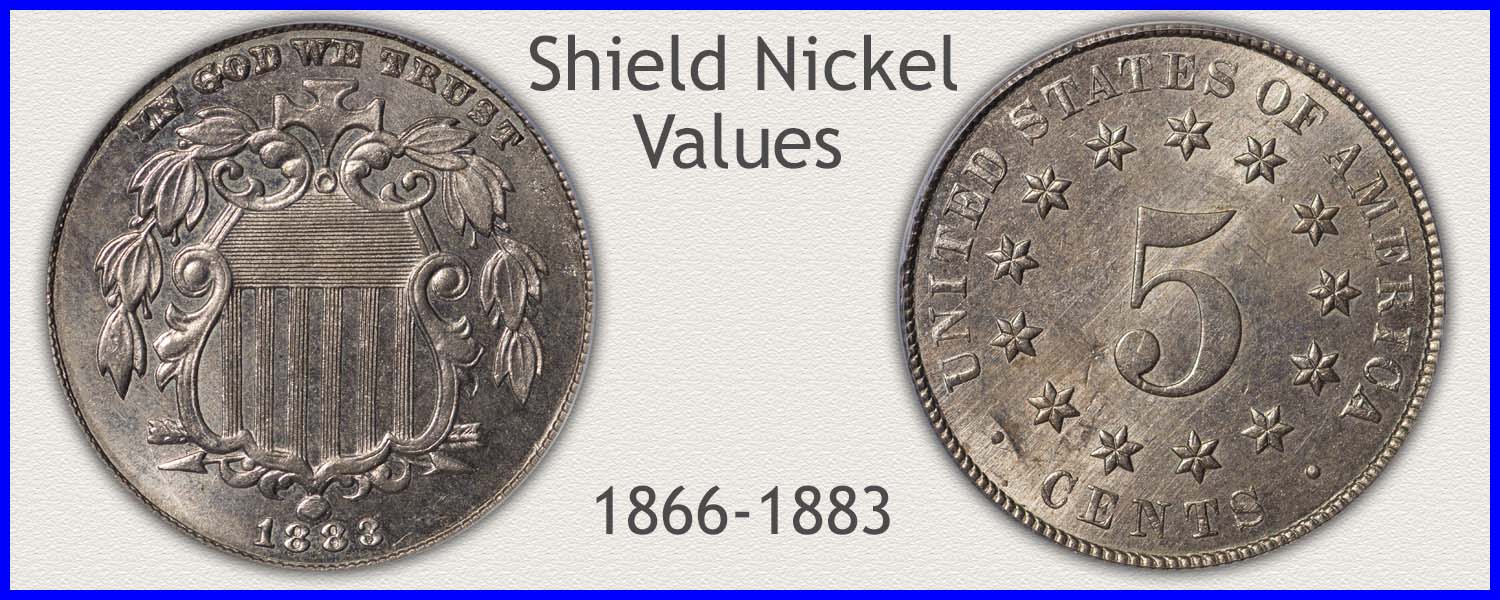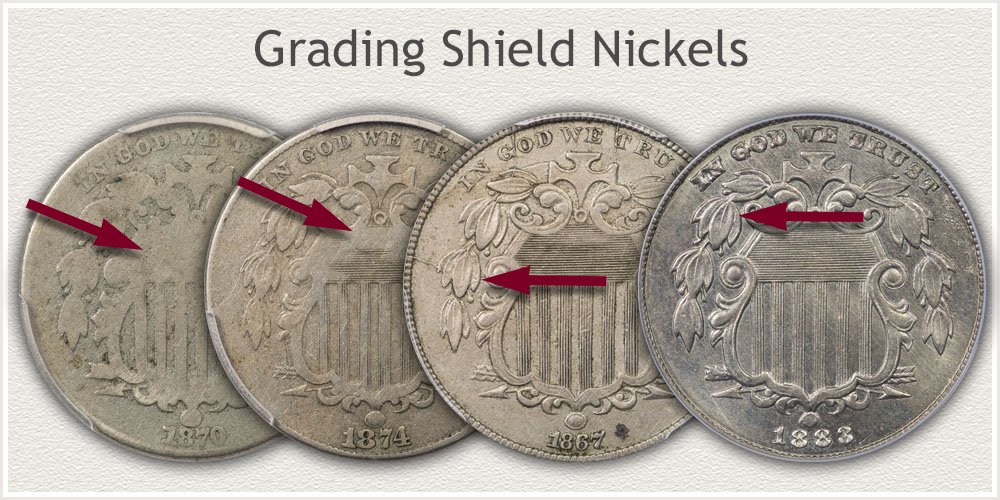Coin Values Moving with Precious Metals: Up-Dated 12/15/2025: Gold $4341 | Silver $63.26
1883 Shield Nickel Value
Use a step-by-step process to determine the 1883 Shield nickel value. This year of the Shield nickel series became a transitional year in nickel coinage. Ending the Shield design and introducing the Liberty design. With both designs minted in one year, a fascination with nickel coinage developed. Interest by the coin market and collectors supports strong premiums for the coin.
Reference the Shield nickel image to confirm the design series of your coin. Liberty Nickels of 1883 covers the second design of this popular year in nickel coinage.
Inspect these coins closely. Starting with the chart, this lists a range of how much an 1883 Shield nickel is worth.
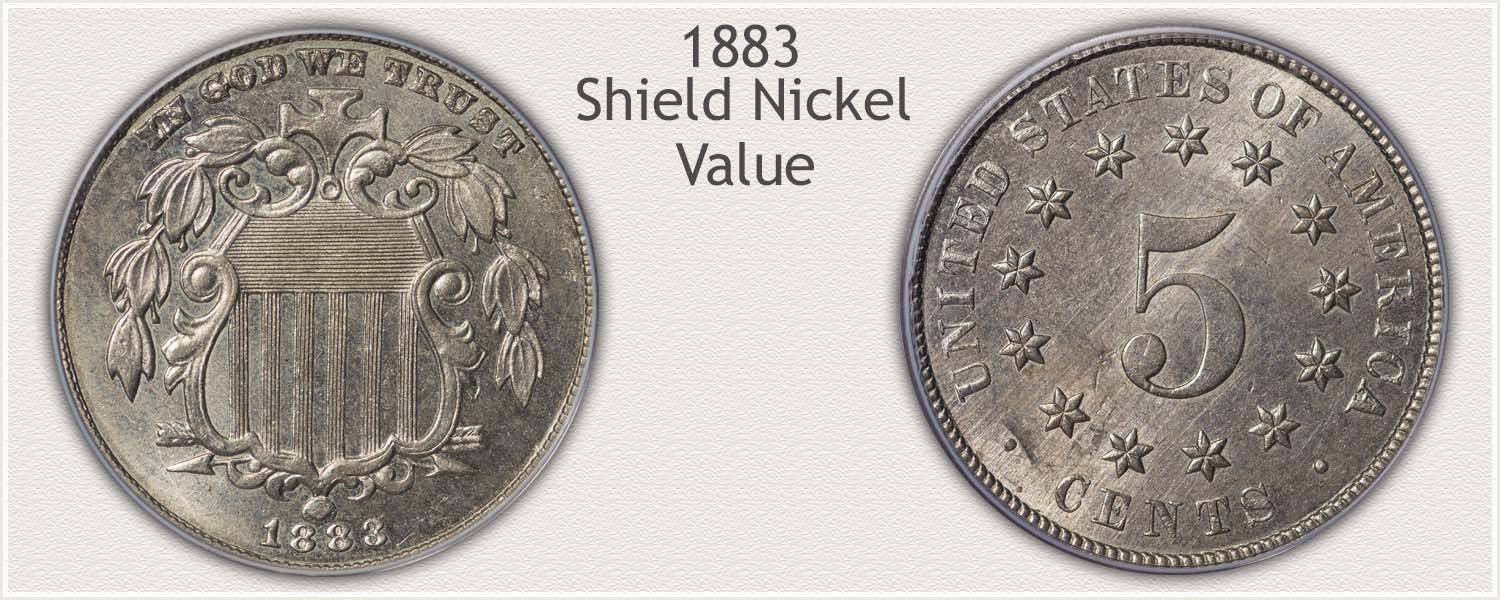
Steps Leading to Value:
- Step 1: Date Identified - A small size date, difficult to read. Confirm with a second look. Also, confirm the Shield series.
- Step 2: Grading Condition - Although all states of preservation enjoy nice premiums. A narrow grade range finds its accurate listing on value charts.
- Step 3: Special Qualities - Compared to other nickel series, mintage totals highlight why a Shield nickel is worth strong premiums.
| 1883 Shield Nickel Value | ||||
|---|---|---|---|---|
| Condition of Coin | ||||
| Date | Good | Fine | Extremely Fine |
Mint State |
| 1883 Shield Nickel Value Updated | 2025 | |||
| 1883 | $20 | $24 | $52 | $98 |
Entries in the chart represent wholesale value ranges. A slight difference in a coin's condition contributes to higher or lower premiums. Additionally, market strength and dealer needs determine how much these nickels are worth.
Step 1: 1883 Last Year of the Shield Nickel Series
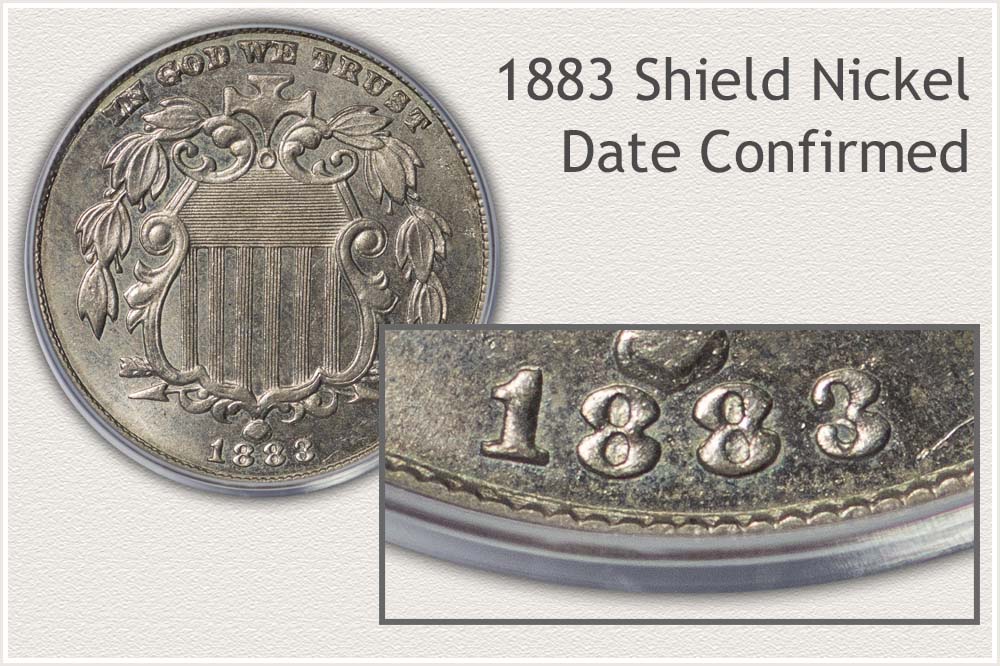
Many collectors consider the first and last years of a series as compelling coins to own. 1883, because of its "last year" of the Shield nickels, enjoys steady demand. A popular year and affordable to all levels of collecting, this forms a strong base for their value.
The Philadelphia mint ended Shield nickel production in early 1883. A new "Liberty" nickel was introduced and minted during the rest of 1883. Sharing a design year with another series adds to the Shield nickel appeal.
The date on these nickels is very small. Inspect below the shield, 1883, in a vintage style, is in the area above the rim. Compare your coin to the illustration, confirming the date. Next, record the date as part of an accurate description of the coin.
Step 2: | Identify Clear Details Deciding a Grade Rating
Narrow 1883 Nickel Value by Judging its Condition
1883 nickels are a standout year of the Shield series. Demand is strong because it shared the year's production with the new Liberty nickel. To accurately determine the coin's value, condition becomes the next important factor. Judging condition, known as "grading," separates levels of remaining detail into grade terms. For example, a "Good" grade defines a coin showing heavy wear and few details. Collectors and the coin market use grades to define different levels of condition.
Below are images of professionally graded Shield nickels representing grades. A close match of your coin to an image finds a narrow grade range. Specific details point to areas to focus an examination. These key features, when clearly visible, identify each grade level. The description highlights the amount of detail required, confirming the grade.
Mint State Grade
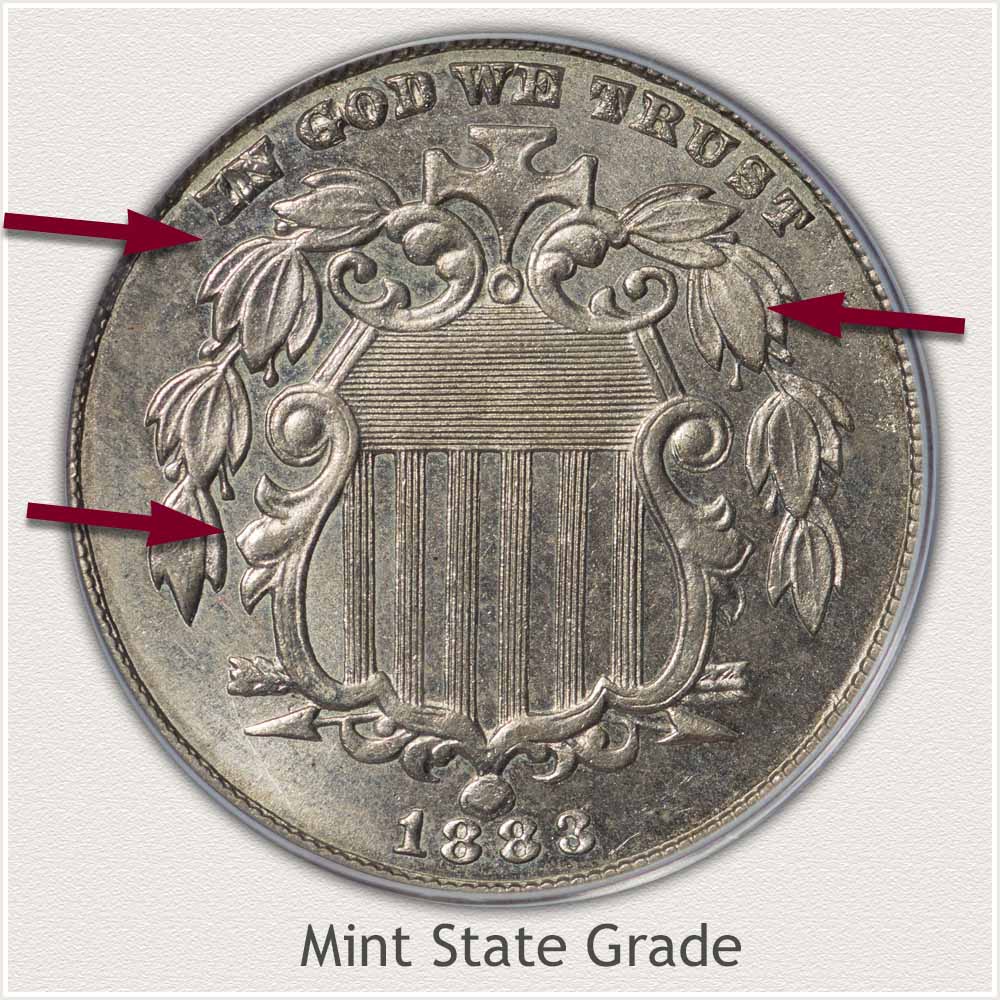
Mint State: No wear to the surface is the primary definition of a coin in Mint State grade. A grading process examines raised contours to verify this strict requirement. Fine, visible detail indicates a high condition nickel. These have the potential to grade at the Mint State level.
Closely examine the example 1883 Mint State nickel. A grading method of comparing high to low relief areas looks for similarities. Notice the luster on high and low contours. The minting process imparts a fine grain texture on the surface. Reflected light from original texture creates luster and brilliance seen on the surface.
Focus on the leaves to the left of the shield. These are well struck on this specific coin. First, examine the high relief, outer edges, and very tips of the leaves. Next, the central vein. When compared to the inner leaf area, a low contour, all are similar in appearance. Any wear shows on high points as flattened and smooth areas on the metal. Wear also imparts a metallic shine, often a gray color. A worn surface has a distinctly different look when compared to an unworn surface.
Use the same approach, and closely inspect high and low areas on the frame of the shield. Again, inspecting the left side, large, rounded, and high areas remain covered in luster. These high points of the frame show the same luster as the field nearby. With the leaves and frame having a consistent texture and luster, this coin is Mint State grade.
Extremely Fine Grade
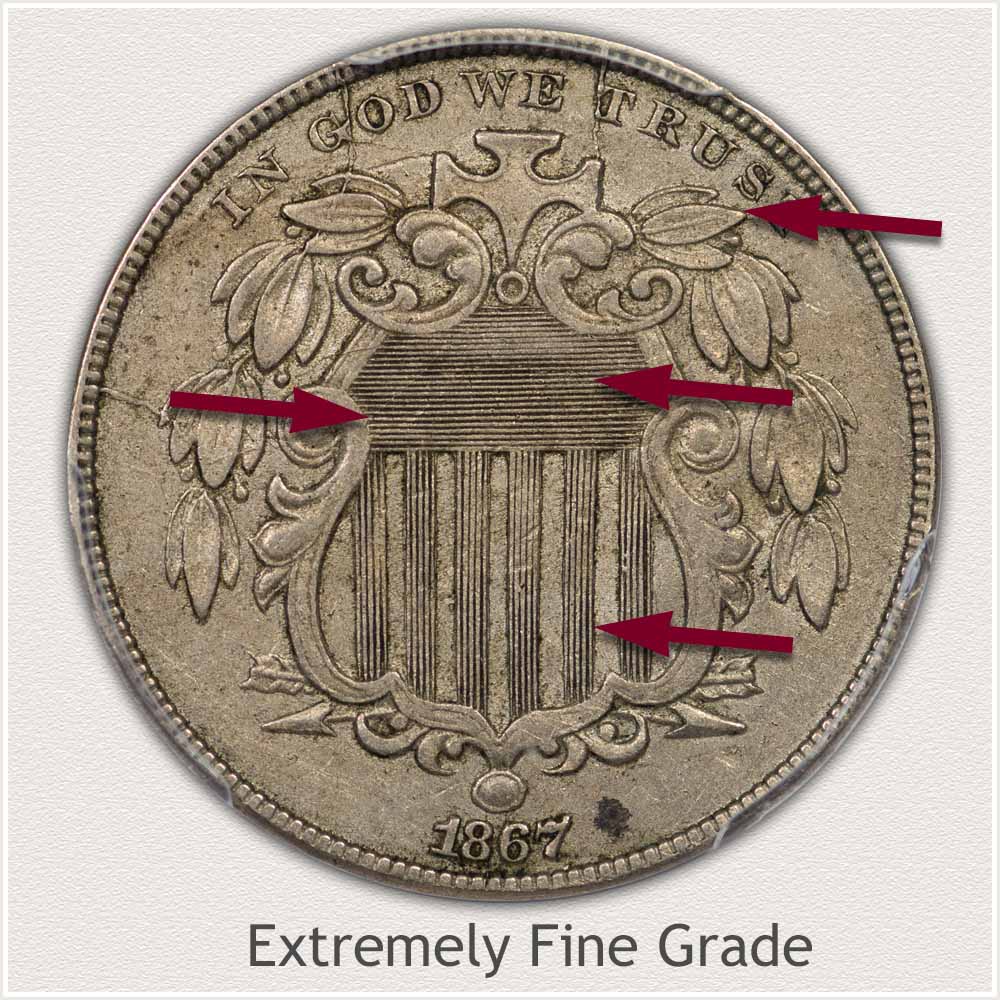
Extremely Fine: A well-defined coin is the first impression of an 1883 nickel in Extremely Fine grade. Light wear smoothing only the highest areas defines the grade. These collector quality Shield nickels are difficult to find in this pleasing condition. Compare your coin to the reference image. Examine for fine lines in the center and high-quality detail within the leaves. The shield's center, border, and leaves, are measurable areas indicating levels of wear. Grading this wear determines its grade.
Also inspect the vertical lines in the center of the shield area. These lines are well-defined and sharp. There is no significant wear or smoothing of these lines. Slight fading between two small areas is acceptable at the grade level. Horizontal lines are also very sharp. Combined, most fine lines within this main focal point are identifiable. Slight smoothing does not detract from a quality appearance.
Next, examine where the border meets the horizontal lines. Both the border and lines are distinct without fading into each other. A nice line on the border remains, separating the two features. Apply this same grading standard to the vertical lines meeting the border. Along the lower ends of the lines, a raised border edge remains.
Now evaluate the visible leaf detail on the sides of the shield. These leaves display slight flattening on the high relief edges and tips due to wear. However, all details show clearly. Signs of wear within the center of the leaves are minor. Clear lower recesses and veins with stems are bold. A small amount of smoothness is the only evidence of wear on the edges of the leaves.
On the example image, notice the difference in design clarity from the left to right side leaves. This becomes a subtle consideration with grading. On your coin, judge the stronger quality leaves for a true indication of the amount of wear.
Fine Grade
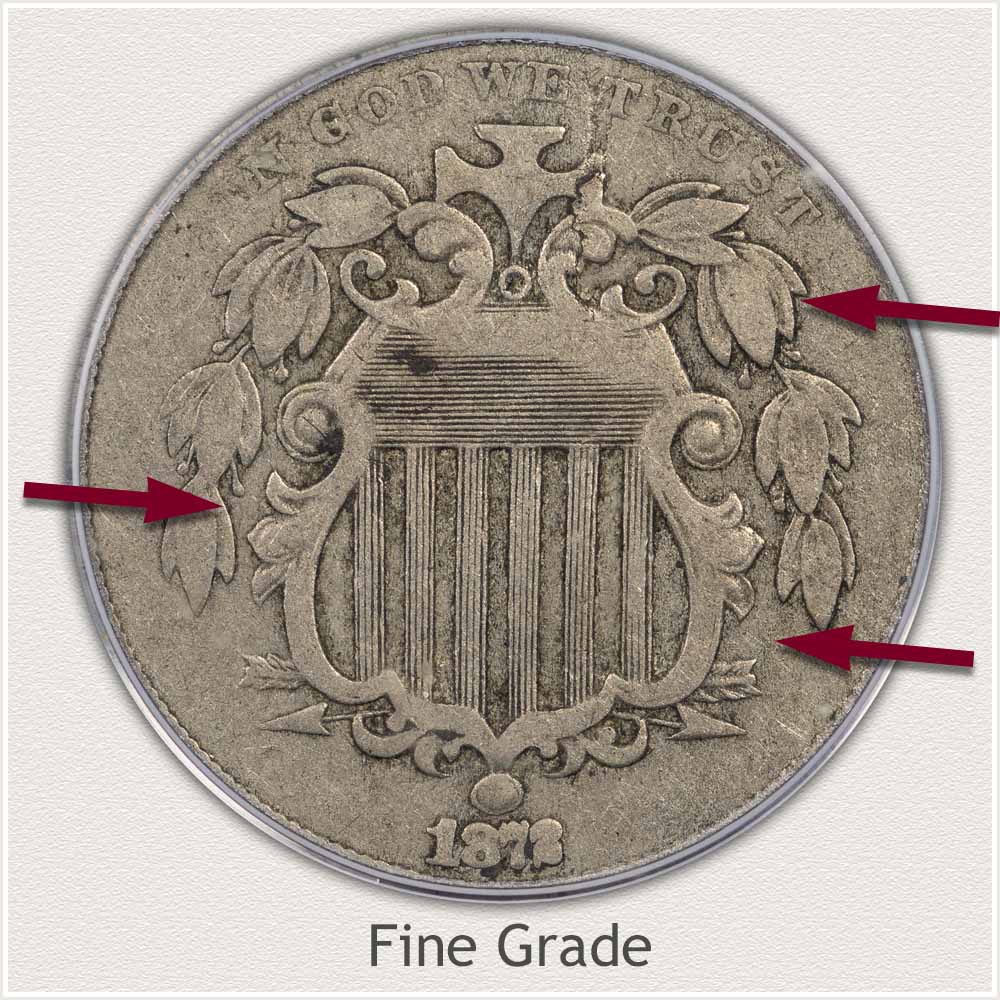
Fine Grade: A Shield Nickel in Fine grade exhibits obvious wear across most of its features. Although wear is noticeable, it does not merge separate elements into flat surfaces. It is the lack of merged lines keeping the coin at the grade level. Intricate details offset many worn areas, giving a quality impression.
Judge the amount of remaining detail in two areas of intricate detail. First, inspect the olive branches and the shield border. These areas exhibit moderate wear without losing their distinct forms. A lack of extensive merging of details is a key factor in maintaining the coin's quality impression.
Examine the olive branches located on either side of the shield. The clusters of leaves, are excellent indicators of the coin's wear level. Wear flattens some of the leaves. However, most display inner contours and central veins. Flattened areas concentrate at the leaf tips and partly across the leaf. Strong edges to individual leaves and low relief areas remain. Compare the wear on your coin's leaves to the illustrated Fine grade example. Note the number of strong edges and the many inner leaf details as a comparison.
Next, examine the decorative shield border, particularly near the last leaf clusters. This area of the border still features curved and contoured areas with deep recesses. Areas along the frame above and below are smooth, without contours. This combination of flat areas and detail indicates a Fine grade coin.
View the coin overall. Judge the balance of visible detail against worn areas. When it favors visible detail, the condition is within the Fine grade range.
Good Grade
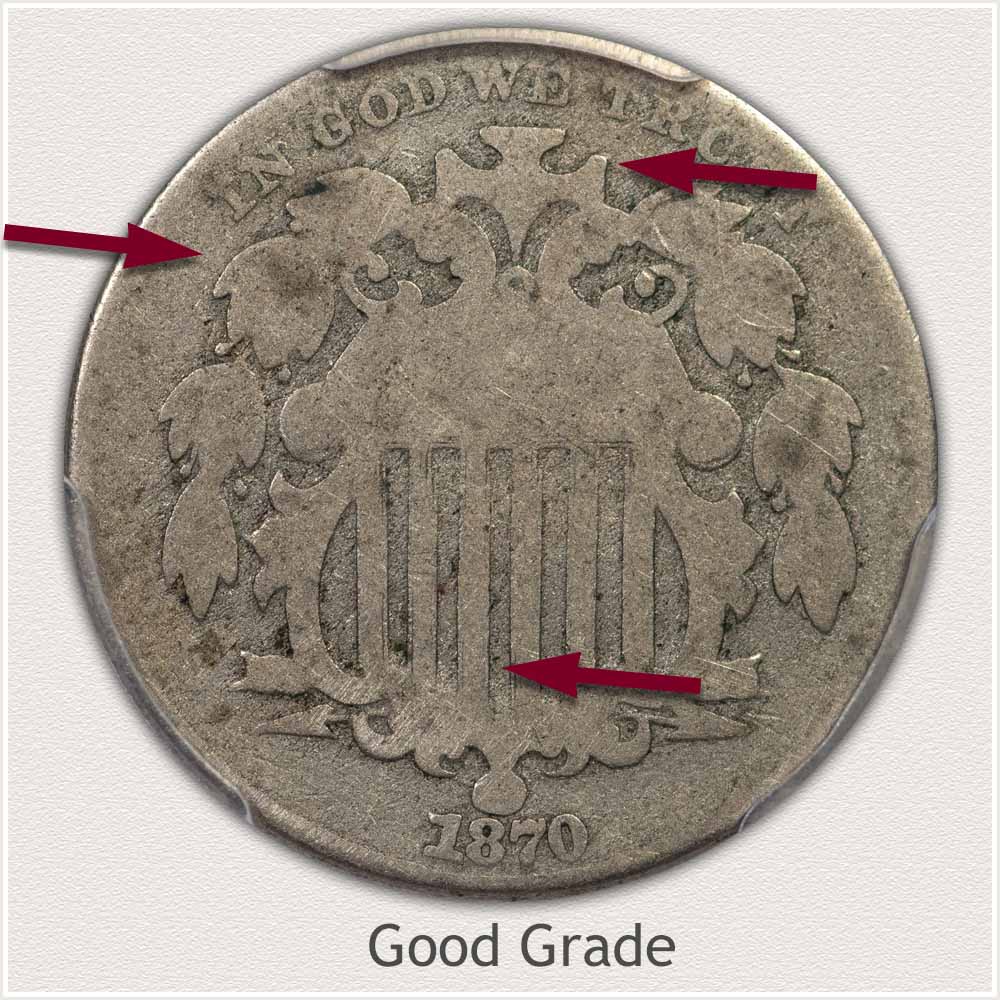
Good Grade: A Shield Nickel in "Good" grade condition exhibits extensive wear. Only the major design features remain visible as outlines. The coin's surface appears smooth, with missing finer details. Remaining elements allow for identification of the coin and its grade.
Examine the extent of wear on three major design features. The shield, leaves, and cross all appear flattened and lack any central fine details. However, these elements have a clear separation between them.
Starting with the leaves of the wreath. Although worn flat, their outer edges do not merge with the field of the coin. Distinct leaf groups remain well-outlined, but lack internal detail.
The shield shows a complete outline, separate from the leaves on either side. Within the center of the shield, vertical stripes are also distinct. Often, a few subtle elements are visible, indicating that wear is not overly extensive. On the example, notice a few fine lines remaining in the stripes toward the bottom of the shield. These are a nice addition to its quality.
A full cross is at the top of the shield. Its outline is complete except where it meets the border of the shield and branches. Without a line separating the cross from the shield, this indicates the Good grade. Compare your coin to the image. A close match of strong outlines and smooth areas identifies the grade category.
How to Video: Grading Shield Nickels
Step 3: | Special Qualities | Shield Nickels and Their Basic Scarcity
Mintages Identify the Shield Nickel as a Scarce Type
1883 finds changes to the nickel design as production began at the Philadelphia mint. Introduced was A new "Liberty" nickel. By mid-year this ended the "Shield" nickel design of the past eighteen years. The chart illustrates the yearly mintage totals of Shield Nickels struck for circulation.
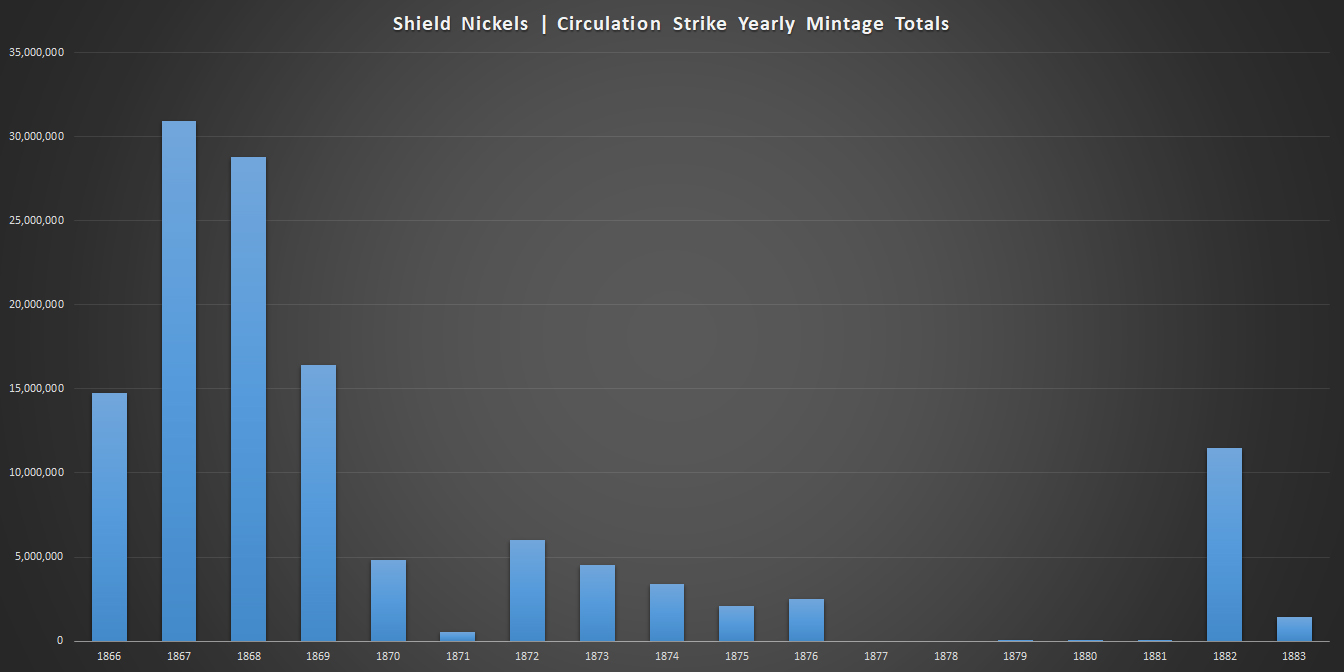 Yearly Mintage Totals of the Shield Nickel Highlight the Scarce Years
Yearly Mintage Totals of the Shield Nickel Highlight the Scarce Years
Shield nickels started strong in 1866, issuing tens of millions in four years. A five-cent domination was scarce at the time. This large amount satisfied demand in commerce. With ample supplies of a new "nickel" coin, it became important in every day trade. The coin was quickly accepted and popular.
Throughout the 1870's, nickels were produced as needed. The mint in Philadelphia responded to the demands of the U.S. economy. Yearly totals trended downward, reflecting adequate supplies. New yearly production replaced damaged, lost, and retired coinage.
When the Shield design ended in 1883, a total of 127 million nickels represented the series. Over the years, individual dates recorded both very high and low mintage numbers. Interestingly, in 1877 and 1878 the mint skipped production of nickels for circulation. When production resumed, 1879 through 1881 saw mintages of only thousands. These are very high value coins today.
The significant fact is only 127 million was the total production for an entire series. All Shield nickels are scarce in comparison to later nickel series. Liberty, Buffalo, and Jefferson nickel designs far exceed 127 million.
Shield nickels represent the beginning of a new type of U.S. coinage. They were minted in comparatively low numbers. Many years of the short series are very scarce, and some years very rare. Overall, any year Shield nickel is a special quality coin.
References
U.S. Mint. 1888 U.S. Mint Annual Report
https://nnp.wustl.edu/library/book/313
U.S. Mint. Catalogue of Coins of the United States
https://nnp.wustl.edu/library/book/554591
Coin Values | CoinStudy Articles
Date by Date
In Depth Shield Nickel Value
Shield Nickel Value | Complete Value Chart of All Years
Sixteen different years of Shield Nickels went into circulation. 1883, last year of the series, is a date popular with collectors. When comparing premiums of all dates, it becomes notable all are scarce.
How to Grade Shield Nickels | Visual Guide
When viewing the grading guide, examine various levels of wear and how they determine a grade. The grading descriptions and images indicate major points of the coin design. A close inspection of these features evaluates the condition of a Shield Nickel.
Coin Value Guide | How to Value a Coin Collection
A step-by-step method combined with images works through how to value a coin collection. Sort and organize coins in a defined process. Identify each coin with accuracy, recording important details, and covering key features. Discover how much your box of old coins is worth.
Print (Printable) the Coin Values Worksheet
After following the steps above to evaluate coins. Print the worksheet and list your Shield nickels along with the rest of your collection. Record the important details and descriptions to accurately evaluate each coin. This written record organizes the holdings and records their current values.
Coin values follow the popularity of a series. Large numbers of collectors create demand, resulting in premiums paid for coins. Insight into the popularity of a coin series highlights the strength of its value. Charts rank the interest of collectors by denomination and series.
Rare Nickels of the Twentieth Century
Many identifiable characteristics on nickels, such as mintmarks, and varieties are elusive. Making certain nickels truly valuable. Early Shield and Liberty nickels are basically scarce. The Jefferson and Buffalo series contains scarce mintage nickels. Highlights include collectible mint errors, and rare condition nickels.
★Coin Values Discovery finds 1883 Shield Nickel Value and...
Charts of U.S. coin values. A process of defined steps identifies features used to narrow a value range on the charts. Using images, recognize the different coin series and varieties. Completing the steps discovers how much a box of old coins is worth.
